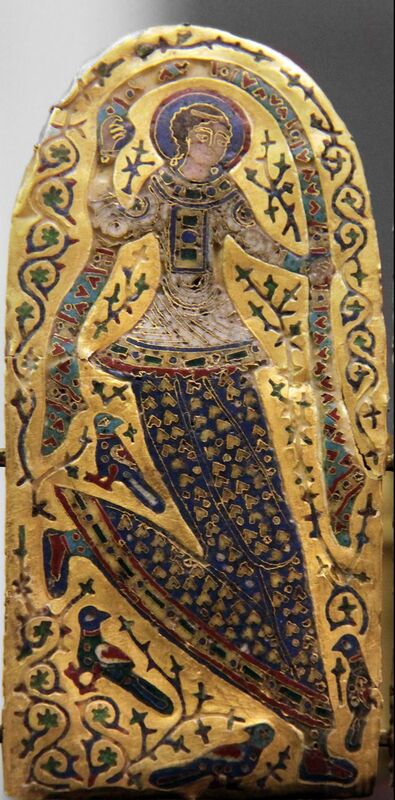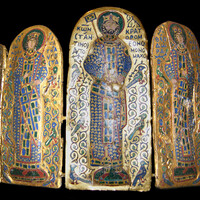Monomachos Crown
Type:
Crowns
Date:
1042
Location or Findspot (Modern-Day Country):
Turkey
Dimensions:
Plates are 3.5 cm wide and between 10 and 4.5 cm tall
Description:
The so-called Monomachos Crown was discovered in 1861 near the Hungarian village of Nyitraivánka. Its seven connected gold plates are decorated with cloisonné enamel. Birds and foliate ornament surround a series of figures: Constantine IX Monomachos (r. 1042–55), Empress Zoe (r. 1028–50) and her sister Theodora (d. 1056), the apostles Peter and Andrew (who were associated with Rome and Constantinople, respectively), a dancer, and personifications of Modesty and Truth. This crown lacks the gems and pearls more typical of a royal crown (compare to the crowns in the Zoe mosaic at Hagia Sophia). It may instead have been an object (not necessarily even a crown) presented to a triumphant commander after a military victory or during a festive event (which would make the dancing figures more appropriate). Its original function and how it ended up in Hungary are still matters of debate.
Constantine IX was the third husband of Empress Zoe (her successive marriages resulted in a series of updates to her portrait at Hagia Sophia). Her first and second husbands, Romanos III (r. 1028–34) or Michael IV (r. 1034–41), died under unusual circumstances. After Michael IV's death, his nephew Michael V became emperor. He exiled Zoe, which incited popular uprisings in Constantinople. After he was dethroned, Zoe ruled with her sister Theodora as joint empresses. Two months later, she married Constantine IX and transferred power to him.
Constantine IX was the third husband of Empress Zoe (her successive marriages resulted in a series of updates to her portrait at Hagia Sophia). Her first and second husbands, Romanos III (r. 1028–34) or Michael IV (r. 1034–41), died under unusual circumstances. After Michael IV's death, his nephew Michael V became emperor. He exiled Zoe, which incited popular uprisings in Constantinople. After he was dethroned, Zoe ruled with her sister Theodora as joint empresses. Two months later, she married Constantine IX and transferred power to him.
Relevant Textbook Chapter(s):
6
Repository and Online Resources:
• The Monomachos Crown is now in the Hungarian National Museum, Budapest.
• View a coin of Michael IV.
• View a coin of Zoe and Theodora.
• View a coin of Constantine IX Monomachos.
Image Credits:
Wikimedia Commons


